
Section II: Big Messages to Communicate Around Learning from Experience

 | The Keys to Inquiry Section II: Big Messages to Communicate Around Learning from Experience |  | ||
| Everyday Classroom Tools | ||||
Okay, so you're ready to begin designing your classroom practice around concepts in The Everyday Classroom Tools Project. What are the big messages that you intend to communicate to your students?
Inquiry Involves Risk-Taking
Asking questions involves taking risks. How can you communicate this big message to your students
and help them take risks in their learning? What does this mean in a concrete sense? There are at
least three areas where teachers can help students learn to feel comfortable taking risks in their
thinking: 1) The environment must support risk-taking in learning; 2) The curriculum needs to allow
for some uncertainty and ambiguity about exactly what children will learn; and 3) Students need
opportunities to learn forms of thinking that embody risk-taking and openness.
1. The environment needs to support risk-taking in learning.
Contrast the following two classroom scenarios. Which one encourages students to engage in more risk-taking? What is happening in one classroom as opposed to the other and why does it encourage students to take a risk?
Teacher Response
Teachers in the Everyday Classroom Tools Project were asked what kinds of things they could do to create an environment that is conducive to inquiry. Here is some of what they had to say:
It is also important to help your students understand the rationale behind the things that are done to help support taking risks in learning and thinking. In the context of classroom discussion, make a point of explaining that we respect many different ideas to encourage everyone to get involved, think through problems, and to separate critiquing from generating concepts. Understanding that certain types of environments inspire good open-minded thinking in science will help them to go off to seek out and/or recreate such environments when they are adults.
2. The curriculum needs to allow for some uncertainty and ambiguity about exactly what children
will learn.
One of the puzzles for teachers around inquiry-based learning is that they worry about what content children will learn. The learner-directed nature of inquiry-based learning means that teachers can't dictate learning outcomes as much as they may have felt they could with more traditional curriculum. This bit of uncertainty raises concerns for some educators and parents.
What should teachers do? Well, first of all, it's important to realize that there are lots of ways to come at teaching the same set of underlying science concepts. Of the many questions that children ask, there will be a whole set of them related to evaporation and condensation, for example, or to weight and density, for another example. By deciding which questions to pursue with greater depth, teachers do have the ability to choreograph learning to a certain extent.
It's also important to realize that part of the uncertainty is because students are learning so much more than content. They are learning how science is conducted. This provides them with tools that will serve them throughout their lives even when the content knowledge that they have learned has become outdated.
At its best, inquiry-based learning starts with children's questions and with their prior knowledge and experience. A wealth of learning research underscores the importance of starting with what children already know in helping them build new understandings. Sometimes this means that teachers find themselves faced with more basic questions than the curriculum objectives that they hoped to achieve. So, should teachers address these more basic questions or those called for by the curriculum? The choice here is very clear based upon what we know from research on learning. Without understanding the more basic questions, children can't develop an understanding of the more complex ones.
In order to learn to understand concepts deeply, students must have a conceptual framework to fit the information to. Learning can be thought of as constructing increasingly complex networks of connections and understandings. If we teach concepts and facts that are isolated from students other knowledge, they will have little basis for understanding it and remembering it.
It's not only important to start from what kids say they know, it's important to probe those understandings and make sure that kids really do understand what they think they do.
3. Students need opportunities to learn forms of thinking that embody risk-taking and openness.
There are different modes of thinking and these modes map onto to different problem types to help us think well in a variety of situations. Researchers David Perkins and Shari Tishman refer to seven different thinking dispositions and the sensitivities, skills, and inclinations that are associated with each. At least two of these relate to the open-ended forms of thinking: 1) The disposition to be broad and adventurous and 2) the disposition towards wondering and problem-finding.
A description of each form of thinking is provided below. Each form of thinking has a set of key moves defined by Perkins, Tishman, and colleagues. Additionally, a set of prototypical questions can be associated with each key move. The key moves and questions are given for each disposition.
2. The disposition toward wondering, problem-finding, and investigating- The tendency to wonder, probe, find problems, a zest for inquiry, an alertness to anomalies and puzzles, the ability to formulate questions and investigate carefully. It's purpose is "to find and define puzzles, mysteries and uncertainties; to stimulate inquiry" according to Tishman and colleagues.
In addition to helping students use these forms of thinking in their school science, encourage them to use these forms of thinking on their own in their every day lives. It's important for them to see how thinking in the ways outlined above led to noticing something of interest or brought them to a deeper understanding and so forth. Linking the form of thinking to an improved outcome increases the chances that students will engage in the thinking on their own.
1996 by the President and Fellows of Harvard College (on behalf of Shari Tishman and Tina Grotzer of Harvard Project Zero). Reproduced here with permission. All Rights Reserved. "Key Moves" developed by Shari Tishman in conjunction with The Patterns of Thinking Project. The project was supported by the MacArthur Foundation through a grant to the Co-Principal Investigators, David Perkins and Shari Tishman. "Sample Questions" developed by Tina Grotzer.
Observation is an Important Means for Learning
What does it mean to really look? Is there a difference between looking and seeing?
These are good questions to ask your students. Their responses can help introduce explicit discussion on the how we observe the world around us and how sometimes we don't.
Often when you ask students these questions, they respond with statements like:
Much of our cognition is pattern-driven. This has both benefits and drawbacks. We need to be somewhat selective about what we pay attention to or our world would be overwhelming to us. Beyond this, attending to certain kinds of patterns is more efficient than others. For instance, noticing the relationship of the hands on the clock to each other is probably much more helpful to us than noticing the color or form of the markers between the numbers. At the same time, our tendency towards efficiency can also keep us from noticing certain patterns in our world. It can keep us from noticing and thinking about everyday patterns that are all around us.
1. We can learn a lot by noticing what goes on around us.
The difference between looking and seeing in the exercise above really comes down to "active processing." When we actively process information around us by perceiving it and reflecting upon it, we are much more likely to notice patterns, to make connections to other things that we know, and to develop an appreciation for what we are looking at. Stopping to reflect can lead to noticing puzzles and deepened understanding. It's important to help kids understand the importance of noticing patterns and to experience the rewards of deeper understanding from doing so.
2. Noticing patterns is a first step in asking why certain patterns exist and why there are certain puzzles or oddities in patterns.
As we start to notice patterns, we also begin to notice puzzles to be explored in the patterns. These puzzles can lead to a deeper understanding of our world. For instance, in the Everyday Classroom Tools Project, students are encouraged to begin to notice different patterns that are related to the seasons. As they start to notice these patterns, they uncover puzzles that reveal areas that need investigation in order for the students to understand them. It helps students to self-assess their knowledge--seeing that there are questions that they don't have answers for.
3. We need to try to think openly about what we experience, think about tendencies or "lenses" that may be limiting.
Even when we are trying to remain open in how we observe, there are certain obstacles that can get in our way. For instance, what do you see in the two drawings below?
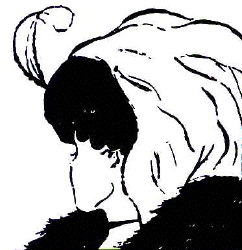
|

|
We need to try to keep our thinking as flexible as possible and not get stuck in one way of seeing something. This is discussed further below.
Keeping Records Helps in Exploring and Sharing Patterns
Keeping records of our observations can help us to explore and understand patterns as well as share
and discuss them with others. Drawing upon tools can extend our ability to detect and share patterns
as well. Each point is explored in turn.
1. Keeping records can help us to explore patterns.
Keeping records of experiences can help in detecting patterns. Not all patterns in the world occur close enough in time that we can detect them just by looking. In addition, micropatterns and macropatterns can sometimes tell a very different story. Keeping records of events can help us to notice patterns over time and in broad and small scale. For instance, if we were to observe the weather in a given area for a week in the summer, it is possible that we would decide that a given area has very dry and hot weather. If we expand our looking by keeping records over the course of a year, we may see that at certain times the weather is very wet while at other times, it tends to be drier. If we extend our looking by keeping records (or looking at kept records) over the course of a number of years, then we might see quite different patterns.
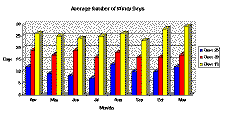
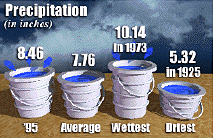
Time helps the create context. We sometimes take the context of our experiences for granted until some child asks a question that reveals that we hold a different context than he or she does. Questions like, "Were there refrigerators when you were a kid?" or "What was the cold war?" remind us that we interpret our experience through the context of earlier experiences. The blizzard of '78 is ancient history to kids, but part of our recent memory. Long-term knowledge of weather patterns accumulates to provide a rich context in which to interpret information that we receive from the environment. We've experienced a different set of extremes and have a greater sense of norms.
Teachers who focus on inquiry-based learning need to keep these differences in mind. In so doing, teachers can help children use tools to help them see patterns in their experiences (charts, graphs, journal entries, etc.) Teachers can also help children learn to look at records of patterns charted. This invites children to benefit from the experiences of others--to benefit from a rich history of accumulated knowledge of patterns. The sharing of patterns, both those the kids find and those that others have found, is where we turn next.
2. Recording patterns makes it easier to share and discuss them with others.
We may sense that a certain pattern of events is occurring or has occurred. By recording our observations, we amass evidence that helps us detect the pattern and share the pattern with others. This is particularly important in classrooms using mediated constructivism as a means to advance knowledge. The collecting of evidence allows individual learners to detect patterns and to construct understanding of them, while it provides a means to share them with others such that the community of learners benefits from the collective experience of those in the group.
Sharing recorded patterns with others invites consideration of discrepancies in the patterns that individuals find. Scientists record and share their data with others. This invites discussion about the data and opportunities to notice discrepancies between data sets and to seek and evaluate reasons which help to explain the discrepancies. Often this points out differences in how data was collected and often, it highlights variables that need to be taken into account. For instance, one student may have collected the shadow data in Figure 1 while another student collected the data in Figure 2. A priori, the students may not have had a clue that they needed to also attend to what time in the day they collected their shadow lengths. However, by looking at the discrepancies between the data they collected, they can construct and understanding of the importance of the variable, "time of day."
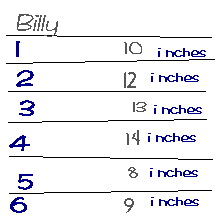
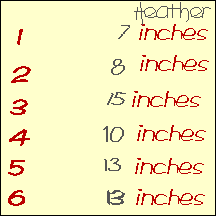
Sharing recorded patterns with others invites consideration of the best mechanisms by which to share patterns. Different types of graphs emphasize different aspects of patterns and thus the choice of graph is a decision about how to communicate one's experience to someone else. For instance, the two graphs below emphasizes different aspects of the same form of data--information about rainfall. One graph is intended to emphasize the types of weather relative to other types (the pie graph) whereas the other (bar graph) stresses the seasonal variation in rainfall. Deciding how to present patterns to others involves students in thinking about what it is that they wish to communicate about the pattern.
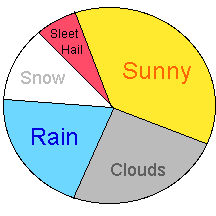

Invite your students to share their data visually and verbally. Provide a safe and supportive "scientific community" where discrepancies in data sets are viewed as scientific questions to be investigated, not errors--but steps on a path of closer approximations to scientific "truth."
3. Tools can help in finding out about patterns.
Not all patterns reveal themselves to us through our direct observation. Tools can help us to see patterns that we otherwise would not see and to learn about the patterns that we do detect in ways that we otherwise wouldn't. Classrooms need to help students view tools as perception-extending devices.
Tools come in many forms. There are actual mechanical tools that serve as aids to perception. These concrete versions are probably the best to help students understand first. For instance, the telescope is a tool for extending vision. The magnifying glass or microscope extends vision in another way.
The internet can be viewed as a special kind of tool of this type. It belongs in a class of tools that extends our ability to experience and share our experiences more broadly. Through the internet, we can extend our sense to know that it is night in Japan when it is daylight in Ohio or that it is winter in Australia when it is summer in New England.
Beyond these actual mechanical tools, are tools that transform patterns in a more abstract sense. For instance, statistical transformations can be viewed as tools that allow us to see patterns in transformed data that were not so accessible to us in the raw data set. Our number system can be viewed as an ingeniously designed tool. For students, these types of tools are probably best understood in the "tool sense" by drawing analogies between these tools and concrete tools students are probably more familiar with.
Interpreting Patterns Involves Seeking Evidence While Looking Out for Discrepancies
One of the primary goals of the Everyday Classroom Tools Project is to get students to notice
patterns in their experience and then encourage them to take the next step and ask "why?" This is
when they go beyond describing and seek to explain, they move from pattern noticing to hypothesis
building. In some sense the distinction is a false one because many scientists hold an a priori notion
of what might happen in their heads and seek patterns that confirm or disconfirm it. In any case, the
pattern noticing doesn't stop because even after scientist notice a pattern and formulate a hypothesis
about it, they continue to seek patterns in a confirmatory or disconfirmatory mode.
Formulating a hypothesis is when you consider what you think might be happening and seek reasons for why you think it might be happening. It is an attempt at interpretation or explanation.
One of the potential pitfalls of formulating a hypothesis is closing off one's mind to alternative explanations. It is important to gather evidence in support of a hypothesis while keeping an eye out for disconfirming evidence, puzzles that can't quite be explained by the present interpretation. Keeping an eye out for potential "cracks" will help your students to evolve the best explanations and to understand that science involves the purposeful discard of theory as better theories come along.
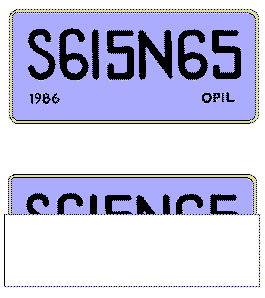
Finding and Thinking About Evidence Evaluation Points
Table reprinted with permission from The Project Zero Classroom
©1997, Tina A. Grotzer, All Rights Reserved.
The following is formatted such that it can be downloaded, printed, and copied to poster size. Click here to see Evidence Evaluation Poster
Often when teachers begin inquiry-based learning with their students, they help their students to
When science class only consists of facts and figure that we know to be "true," it communicates to
students that we know all the answers, instead of letting them know that our ignorance far outweighs
our knowledge. It keeps them from finding out that there are lots of mysteries that we can't begin to
answer. Letting students in on the mysteries of the world ignites their curiosity and opens the door to
a lifetime of finding out. In the late 1980s into the 1990s, NASA conducted the Space Seeds
Program in which they invited school children across the nation to participate in a grand science
experiment in which students compared seeds that had been in space to seeds that served as a control
group here on Earth. One of the many wonderful things about this project was that it communicated
to children that there are questions we don't know the answers to and that they can participate in
finding out.
2. For centuries, people have tried to understand the world and make sense of it based upon what they
could see, hear, etc.
Often the theories that students evolve as they first grapple with explaining different phenomenon are
not unlike those that ancient (and not-so-ancient!) people created to explain similar phenomenon.
This is a common enough occurrence that it is referred to as "Recapitulation" or "Ontogeny
(individual growth) recapitulates phylogeny" (our collective growth). Often the basis for the
similarities has to do with certain ways of seeing and measuring information. Certain perceptual
information seems to lead to certain conclusions. For instance, it does appear that the moon follows
you when you walk, thus young children who interpret it as doing so are basing their knowledge on
what they see just as people did centuries ago. With a balance of constructivism and scaffolding (a
mediated constructivism) we can help students see the common sense of their intuitive theories while
we scaffold them to more current day scientific notions based on our collective knowledge and the
tools and techniques we have available to us today.
3. We all create theories about the world and try to make sense of what we observe. It is important to
continue to visit and revise those theories as we learn to ask increasingly sophisticated questions.
Research shows that we all try to make sense of our worlds and evolve theories about why our worlds
work the way that they do. It also shows that our personal theories are fairly robust because they
make so much sense to us.
A novice looking at weather patterns might consider the localized effects of warm and cold fronts and
the weather implications of the fronts meeting, while an expert might look beyond the immediate
patterns to consider how they are linked on a complex causal relationship with weather patterns such
as El Ninio or with the patterns of flow in the Gulf Stream. Experts are also more likely to contrast
his or her explanation of what is happening with commonly accepted theories to see if it
complements or contradicts those theories and whether he or she had considered the right set of
variables to know.
This finding is certainly not surprising considering that experts have contextualized knowledge,
background information that helps them decide how to attach importance to particular findings.
Indeed as someone becomes expert in a given domain, their manner of attaching importance to
patterns undergoes a shift. This is often referred to as the "novice-expert shift."
What does the "novice-expert shift" imply for inquiry-based science? It presents the need to provide
opportunities for students to generate a spiralling of increasingly more expert questions. Students'
early questions will be those of a novice and only as students seek answers to their questions and gain
in expertise will their questions become increasingly sophisticated and focused on the deep structure
of the knowledge in the domain that they are studying. This doesn't mean that teachers can't scaffold
students' question-asking to some extent and as fitting with a mediated constructivism. However,
teachers should not scaffold students beyond the level at which the questions make sense to the
student and generate from what the student believes is sensible to ask.
This argues for giving students plenty of time to delve into topics deeply. If students are not given
sufficient time to delve into a topic, they will merely inquire at the surface of the topic and never
reach the more meaningful patterns and understandings to be constructed at the deeper level of
structure.
In order to accommodate the "Novice-Expert Shift," the following messages should be communicated
to students and provided for in the course of inquiry:
Author: Tina Grotzer
ECT Home Page | Introduction to the Threads of Inquiry | Contents of the ECT Pages
Inquiry Through Our Experience is Part of a History of Sense-Making
discover the importance of on-going inquiry in a broader sense. They invite their students into the
company of scientists and sense-makers throughout history who have sought to understand the world
that we live in. There are a number of important lessons that students learn.
1. We are still finding out how the world works. We don't know all the answers.
Our Questions Evolve to Become More Expert Over Time
Research shows that experts and beginners tend to notice different kinds of patterns when they
consider scientific phenomenon. Experts structure their understanding and construe meaning from
information differently than beginners. Experts tend to notice patterns related to deep structure while
novices tend to notice more superficial features or may get drawn to those features that most attract
their attention whether or not these are the patterns that are most relevant. Experts tend to consider
the bigger picture so they notice the larger context and larger patterns and implications of patterns.
Experts also tend to monitor their activity in a self-regulatory way.
€Once you've learned certain things, your questions change.
€One question may take you part of the way towards understanding, then you often need to
ask a new question.
€ Deeper questions often come from earlier questions.
€At some point things connect to other things that we know. Try to find those connections to
help you understand both things better.
€Identifying relevant questions is a process. It is fruitful to pursue asking a next and more
sophisticated question.
Project Zero
Harvard Graduate School of Education Introduction
Introduction  Section I
Section I